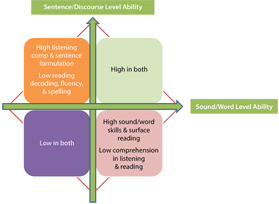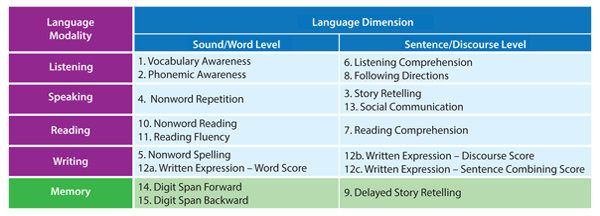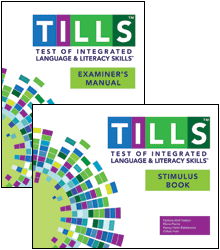TILLS: Discover a better way to assess language and literacy skills
Q. What’s the major goal of the TILLS assessment? What need does it satisfy?
A. The major goal of the TILLS assessment is to identify oral and written language disorders and learning disabilities in school-age students (ages 6–18 years). TILLS is unique in assessing both oral AND written language in a manner that allows comparisons of a student’s sound-word and sentence-discourse level abilities across the four modalities of listening, speaking, reading, and writing. In addition, TILLS includes some subtests aimed directly at measuring aspects of memory that are relevant to classroom performance and performance on the other subtests. TILLS addresses three major assessment goals:
- to identify students between the ages of 6 and 18 who have language and literacy impairments
- to provide information about patterns of language and literacy strengths and areas of concern that will guide next steps in assessment and intervention
- to track changes in students’ language and literacy abilities over time (intervals 6 months or longer)
Q. Can you tell us a little about how TILLS was developed?
A. The four authors of TILLS (Nickola Nelson, Elena Plante, Nancy Helm-Estabrooks, and Gillian Hotz) have been working as a team for more than a decade to develop companion tools for assessing the cognitive-linguistic skills of two broad groups of school-age children and adolescents:
- those affected by traumatic brain injury, and
- those affected by developmental impairments of language and literacy including primary language disorder, learning disabilities, and dyslexia as well as language problems secondary to other conditions.
 The Test of Integrated Language and Literacy Skills™, or TILLS™, is a norm-referenced assessment for which standardization was completed in 2015. The authors based the theoretical model for TILLS at least partially on literature regarding differential diagnosis of spoken and written language disorders (Bishop & Snowling, 2004; Catts, Adlof, Hogan, & Ellis Weismer, 2005), which is represented with the quadrant model shown here (click/tap for a larger view).
The Test of Integrated Language and Literacy Skills™, or TILLS™, is a norm-referenced assessment for which standardization was completed in 2015. The authors based the theoretical model for TILLS at least partially on literature regarding differential diagnosis of spoken and written language disorders (Bishop & Snowling, 2004; Catts, Adlof, Hogan, & Ellis Weismer, 2005), which is represented with the quadrant model shown here (click/tap for a larger view).
As shown in this table (click/tap for a larger view), the 15 subtests of TILLS are designed to assess language levels and related elements (sound-word, sentence-discourse, vocabulary, and memory) across four modalities (listening, speaking, reading, and writing). The profiles that result have implications for differential diagnosis of disorders, such as specific language impairment (SLI) and dyslexia.
Using scientific evidence gathered in numerous pilot studies and field trials, a national beta trial, and a standardization study with more than 1200 children and adolescents from across the United States, TILLS has been finetuned to meet strong psychometric standards. Items and subtests have gone through extensive testing, including item response theory analysis and traditional test standardization research. Exploratory factor analysis indicates that TILLS assesses two latent factors—sound and word structure knowledge and sentence and discourse knowledge, which support the theoretical model on which the test was constructed. In addition, some TILLS subtests purposefully include curriculum-relevant, integrated tasks that do not load clearly on either major factor (consistent with its name, the Test of INTEGRATED Language and Literacy Skills).
The outcome is a psychometrically strong set of tests with scores that can be interpreted as profiles of relative language/literacy strengths and areas of concerns. TILLS is relevant to measuring difficulties students have when facing the complex, integrated language/literacy demands of the general education curriculum as outlined within the Common Core State Standards and other state-generated curricular standards.
Q. What are the major advantages of using TILLS over similar tools? How does it do a better job of meeting the needs of SLPs and the children they serve?
A. First, TILLS will be the only test available that provides information on diagnostic accuracy (i.e., sensitivity and specificity) for every age at which the test is normed. This is critical for evidence-based practice. In this respect, TILLS stands in contrast to most, if not all, other tests, which either provide no information on diagnostic accuracy or provide accuracy data for a single group of children that combines children of different ages. This prevents clinicians from determining the test’s diagnostic accuracy at the particular age of the child they wish to assess.
Using TILLS, clinicians can administer the identification core subtests for diagnosing a language/literacy disorder in 25-45 minutes, depending on the student’s age and response patterns. Clinicians also can conduct a comprehensive assessment of students’ oral and written language skills and construct a complete profile based on all 15 TILLS subtests in 90 minutes or less, with only a little extra time for scoring. Currently, clinicians must administer multiple tests over multiple sessions and patch together results across measures to conduct a comprehensive assessment of oral and written language skills similar to what TILLS provides. This is not only time consuming, but is a psychometrically questionable practice.
The oral and written composite scores that result from administering a wide mixture of items on some currently available measures also do not yield easily interpretable profiles that can inform intervention. When scores are compared across tests, differences in the normative samples can lead to the appearance of differences across skills that are really only differences in the normative samples of the different tests. TILLS avoids this problem by including both oral and written language subtests within the assessment and basing standard scores on a common normative sample.
Q. In which settings do you see TILLS being used? Is it designed to be given only by SLPs, or can other professionals administer it, too?
A. TILLS is intended for use in schools, clinics, and private practices. It can be administered by speech–language pathologists, neuropsychologists, educational psychologists, and others trained in individualized test administration with children, such as reading specialists, special educators, and other educational specialists.
Q. Is TILLS fairly easy to implement? Does it require special training and expertise to administer?
A. With a little practice, TILLS is easy to give, score, and interpret. The Examiner’s Manual and Record Form include key information needed to administer each subtest; the Examiner’s Practice Workbook provides practice materials for demonstrating how to administer, score, and interpret each subtest. Most speech–language pathologists are already familiar with phonological and syntactic elements that are considered in scoring and interpreting the subtests.
Q. Can you provide a short case example illustrating the benefits of TILLS?
A. Case One. A 7-year-old scores below age-expected levels on phonemic awareness, nonword reading, and nonword spelling tasks, as well as on reading fluency and written expression measures; yet, this child scores well on listening comprehension, following directions, and social communication. For a student with this type of profile, the clinician would likely be able to focus intervention on sound-symbol association and morphological awareness at the word level, while taking advantage of stronger oral language at the sentence-discourse level and social skills in planning intervention and may not need to target those areas in intervention.
Case Two. A 10-year-old shows strong sound-word level skills on phonemic awareness and all the nonword tasks (repetition, reading and spelling), but scores significantly below age level on story retelling (immediate and delayed), as well as on subtests of listening and reading comprehension, vocabulary awareness, social communication, and written expression. A focus on phonics and phonological word structure would not be the best use of treatment time for this student. A better use of treatment time would be to focus on vocabulary, syntax, and discourse skills that could improve comprehension and expression across spoken and written communication modalities, preferably using the student’s actual curricular materials.
Q. What are the next steps a school should take after a TILLS assessment? Does TILLS include guidance on what to do next?
A. The results of the TILLS assessment can be used by Multidisciplinary Evaluation Teams in schools as a critical piece of valid and reliable evidence in deciding whether a student meets eligibility criteria as having a language impairment or learning disability.
TILLS results also may be used to support more specific diagnoses. Consider the following examples:
a. A diagnosis of dyslexia would be consistent with a pattern of low TILLS scores in sound and word structure knowledge, reading fluency, and reading comprehension, but higher TILLS scores in listening comprehension and story retelling. This is the upper left-hand corner of the quadrant model.
b. A diagnosis of specific deficit in the area of comprehension would be consistent with a pattern of relatively better TILLS scores in sound and word structure knowledge and lower TILLS scores in both listening and reading comprehension, as well as problems with vocabulary awareness and social communication. This is the lower right-hand corner of the quadrant model.
c. A diagnosis of general spoken-written language-impairment, which may also be called language-learning disability, would be consistent with a pattern of low skills across both language levels and all four modalities, although perhaps still with some areas of relative strength. This is the lower left-hand corner of the quadrant model.
d. If students’ scores fall in an area of marginal concern, school teams might decide to recommend further instruction in a response to intervention (RTI) model that does not include special education placement. TILLS could be readministered 6 months to a year later to add to other evidence regarding the student’s need for special education.
A companion tool, the TILLS Student Rating Scale, can be used to document parent, teacher, and student perceptions and priorities related to the student’s strengths and needs. Use of both tools is consistent with the requirements of IDEA that multiple methods and sources of input must be used to determine eligibility for services in schools. By considering the pattern of specific strengths and weaknesses for a given student, along with information on the TILLS Student Rating Scale, the team can prioritize intervention targets and know which areas of strength to draw on.



